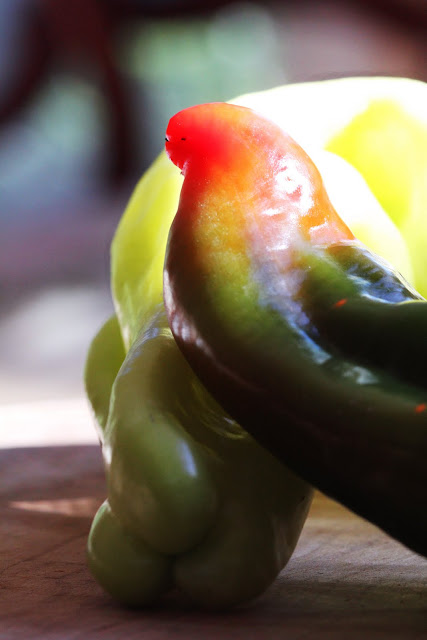Gazpacho.
No one knows a good gazpacho until you try the St. James version.
While at home this past week (let's be honest, there's always an excuse to go to Santa Barbara), I witnessed a wonderful thing. The creation of Homemade gazpacho. The inspiration for this came from the bazillion unripened green tomatoes in our backyard. Nature decided this year to have all her tomatoes ripen at the same time. In order to mollify the possible ramifications of this, my mom and I came up with a way to use some of these guys today. And there it was, gazpacho.
Previously that week we had tried a delicious gazpacho from a little tapas bar called Joya in Palo Alto. Trying to mimic the same flavors & roughly following a recipe in a cookbook from in the abyss we call a cupboard, our recipe evolved (see below).
I decided that I would document this gazpacho process by sitting down at the kitchen table and watching my mom do most of the work, albeit a little bell pepper chopping. She's usually better at these things anyway. I'm better at eating
..we all have our strengths.
GazpachO:
- 1 pound of vine-ripened tomatoes, peeled, seeded and chopped
- 1/2 pound of green tomatoes, peeled, seeded and chopped (unripened)
- 1/2 tomato juice
- 1 avocado
- 1 1/2 cup cucumber peeled, seeded and chopped
- 1/2 cup chopped green bell pepper
- 1/8 of sweet medium-sized melon, such as cantaloupe, diced
- 3 medium garlic cloves, minced
- 1 cup chopped red onion
- 1 small jalapeno seeded and minced
- 1/4 cup EVOO (imported, cold pressed)
- 2 limes, juiced
- 1 teaspoon garlic salt
- 1 teaspoon fresh sea salt
- 2 teaspoons of balsamic vinegar
- 2 teaspoons Worcestershire sauce
- 1/2 teaspoon toasted, ground cumin
- 1/4 teaspoon fresh chili flakes
- 3 tablespoons fresh basil leaves, for garnishing

Directions:
Using a 6-y quart pot, fill halfway with water and set to a high heat. Bring to a boil. In the meantime, mark an X with a knife on the bottom of both types of tomatoes. Drop the tomatoes in the boiling water and about 10-15 seconds, remove them and transfer to an ice bath. From here, allow the tomatoes to cool for about 5 minutes and then peel, core and seed the tomatoes. When you are seeding the tomatoes, set aside the seeds and pulp. With these we will place them over a fine mesh strainer that is set over a bowl in order to catch the extra juice. Add the juice collected in the bowl to a measuring cup. We will use this later. Put the tomatoes and juice into a mixing bowl and add the bell pepper, cucumber, melon, garlic cloves, jalapeno, olive oil, lime juice, balsamic vinegar Worcestershire sauce, cumin, garlic salt, salt, and chili flakes. Stir well until all the ingredients are combined evenly. From here, transfer about 2 cups of the mixture to a blender or food processor and blend for about 15 seconds on high. Take the pureed mixture and mix it back in with the original mixture, stir to combine. Cover and put in the refrigerator for at least 2 hours or overnight. When serving, cut basil into thin neat strips and place on top, accompanied by a quick pinch of sea salt, ground pepper and diced avocado. Voila!
_______________________________________________________________________________
Dishing up Tomato Nutrition
If you're still with me, I'd like to tell you a little bit about why tomatoes are so dang healthy for you.
Tomatoes, or lycopersicon lycopersicum, come from the same family that includes peppers, potatoes and eggplant. There are many different varieties of these nightshade vegetables (and fruit), with just over a thousand varieties of tomatoes that differ in size, shape and color -yellow, red, green, orange and brown.
Tomatoes were originally introduced to Italy in the 16th century by the Spanish, and later brought to America by colonists in Virgina. It wasn't until the 19th century that tomatoes gained popularity. Today, tomatoes are one of the most popular fruits on the market. They are extremely tasty, not to mention extremely healthy for you as well.
Tomatoes are rich in vitamin C and potassium. They are also an excellent source of plant chemicals including phytosterols and beta-carotene. They also provide sufficient amounts of lycopene, which becomes more abundant when the tomato is cooked. I found this striking as fruits and veggies usually lose nutritional value the longer they are exposed to heat. Furthermore, tomatoes have been used for home remedies as well. Taking a bath with tomato juice while drinking a glass of tomato juice simultaneously, has been proven to help with certain skin disorders such as eczema. Another home remedy using tomatoes is to create a concoction using tomato juice and buttermilk and apply it to burned areas of the skin for immediate long-term relief.
In order to maximize the benefit of your tomatoes (smelling, eating, cooking etc.), store them at room temperature -not in the fridge! Fully ripe tomatoes will last for a day or two and should have a mild fragrance. If a tomato has no fragrance, it means that it was picked before it was ripened and will never ripen. Sad day. Lastly, make sure to not cook your tomatoes with aluminum cookware because the acid in tomatoes chemically interacts with the metal and causes the aluminum to leech into the skins.





















